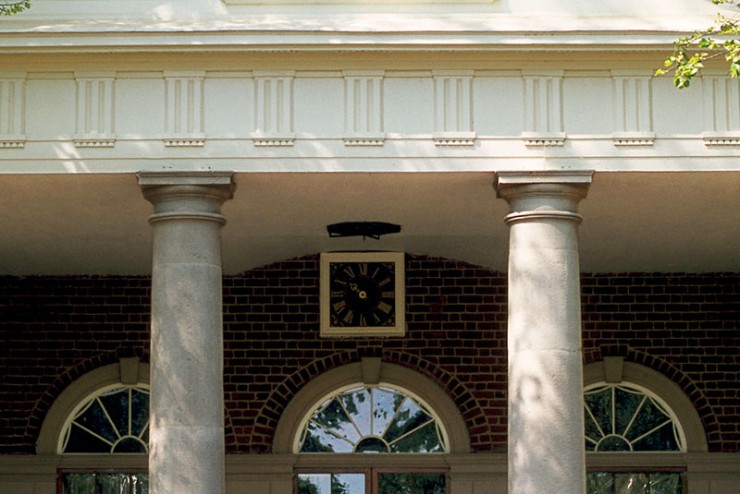One of Monticello's iconic features is the Great Clock, designed by Jefferson, built by Peter Spruck in 1792, and fully functional today. The clock, with both an interior and exterior face, regulated the schedule of the entire plantation, inside the house and out. On the outside wall, the clock has a single hand to incrementally mark the hour. The inside face of the clock hour and minute hands, with a smaller sweep second hand, reveals Jefferson's desire for precision.
The Great Clock Gallery

The Great Clock's interior face features hands for minutes and seconds.

The exterior face of the Great Clock features only an hour hand.

Internal works of the Great Clock

The Great Clock's ball weights descend through the floor in Entrance Hall
Great Clock Short Videos

Monticello's Great Clock

Weekly Winding of the Great Clock

The Striking of the Great Clock

Behind the Scenes: Conservation of Jefferson's Great Clock
Powering the Great Clock
 Great Clock driving weights
Great Clock driving weights Folding Ladder
Folding LadderThe Great Clock is driven by two sets of cannonball-like weights, which hang on both sides of the front doors. On Sundays the clock is wound with the help of a folding ladder, and the weights are raised to the ceiling.
The top ball right-hand set of weights reveals the day and even the approximate hour as it falls past markers on the wall, with Sunday at the top and Saturday at the bottom. The clock is also attached to a Chinese gong that chimes the hour. In the eighteenth century, the gong rang loudly enough for field slaves to hear it three miles away.
 Chinese Gong
Chinese GongA Six-Day Wall
There is a hitch, however; when the weights arrived at Monticello for installation, it was discovered that the height of the Entrance Hall was shorter than the length of the ropes. Jefferson's solution? To allow the weights "to descend naked till they get to the floor where they may enter a square hole and go [on?] to the cellar floor. . . ." The holes were cut, the weights were hung, and the marker for Saturday may be found on the basement level of the house.
